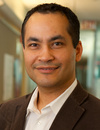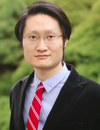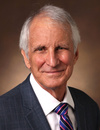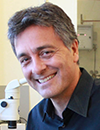08:00 | Morning Coffee, Pastries and Networking in the Exhibit Hall |
|
Session Title: Emerging Themes in 3D-Bioprinting, circa 2019 |
| |
|
Venue: Coronado Ballroom B |
| |
08:30 | Integrating Multiple Biofabrication Technologies To Create Complex and Functional Musculoskeletal Tissue Grafts
Riccardo Levato, Associate Professor in Translational Bioengineering and Biomaterials, University Medical Center Utrecht, Netherlands
Major challenges in musculoskeletal tissue engineering revolve around recapitulating the architecture, and therefore the function, of native tissues. Present strategies to treat chondral and osteochondral defects, including tissue engineering and cell implantation, prevalently result in repair tissue with poor mechanical properties, which is prone to degeneration, and can only delay the insurgence of severe pathologies like osteoarthritis.
Biofabrication is opening new avenues for the restoration of impaired joints tissues. Multi-material bioprinting enables to fabricate composite structures combining cell-laden, soft hydrogels with mechanically strong polymers for structural support. By the accurate 3D patterning of stem and tissue-specific progenitor cells, salient features of the native zonal and depth dependent organization of articular cartilage can be replicated. Alongside hydrogel extrusion and bioprinting, different additive manufacturing technologies, such as melt electrowriting of polymeric microfibers, ceramic plotting and digital light processing lithographic printing of hydrogels, can be combined to create composite, cell-laden constructs that enable integration between engineered cartilage hydrogels and bone scaffolds. These bioartificial osteochondral grafts exhibit improved interfacial mechanical strength, favouring their integration in vivo.
Herein, the latest development in the field of bioink printing to create zonal-biomimetic cartilage constructs will be discussed, together with the integration of multiple (bio)printing strategies (i.e. co-fabrication of hydrogels, reinforcing polymers and bioceramics), and the impact of these technologies towards the generation of fully biofabricated, high-performance engineered osteochondral grafts, with potential application for regenerative medicine. Finally, technological advances and challenges towards the biofabrication of large, clinically-relevant multi-tissue constructs will be discussed. |
09:00 |  | Keynote Presentation Computed Axial Lithography For Volumetric Printing of Soft Structures
Hayden Taylor, Assistant Professor, Mechanical Engineering, University of California-Berkeley, United States of America
Volumetric additive manufacturing is defined as producing the entire volume of a component or structure simultaneously — rather than by layering — and has been envisioned as a possible way to increase the speed of additive manufacturing. Until recently, however, no practicable technique existed for creating arbitrary 3D geometries volumetrically. Recently, we have demonstrated Computed Axial Lithography (CAL) to meet this need. CAL essentially reverses the principles of computed tomography (widely used in imaging, but not previously in fabrication) to synthesize a three-dimensionally controlled illumination dose within a volume of photocurable resin. The photosensitive volume rotates steadily while a video projector illuminates the material from a direction perpendicular to the axis of rotation. The illumination pattern typically changes >1000 times per revolution, so that light from many different projection angles contributes to the cumulative dose. Where the dose exceeds a threshold, the resin solidifies and the part is formed. In this talk I will discuss the CAL process in the context of its possible bioprinting applications. The CAL printing technique has several potential advantages. Because there is no relative motion between the component being printed and the resin during printing, the printing speed is not limited by resin flow effects, as it can be in layer-by-layer photopolymerization-based printing. The absence of relative motion also allows highly viscous resins or soft, highly compliant materials such as hydrogels to be printed. Because layers are not used in CAL, the surfaces of printed components are very smooth (c. 1–4 µm roughness in preliminary experiments), which may open up new applications. Additionally, it is possible to print objects around pre-existing solid objects that could have been made using a different material or process. This ‘overprinting’ capability suggests applications in mass-customization for end users and also potentially in fabricating biological structures with highly heterogeneous mechanical properties. |
|
09:30 | Engineering Human Tissues Using 3D Bioprinting Technology
Jinah Jang, Associate Professor, Pohang University of Science And Technology (POSTECH), Korea South
Recent development in bioengineering enables us to create human tissues by integrating various native microenvironments, including tissue specific cells, biochemical and biophysical cues. A significant transition of 3D bioprinting technology into the biomedical field helps to improve the function of engineered tissues by recapitulating physiologically relevant geometry, complexity, and vascular network. Bioinks, used as printable biomaterials, facilitate dispensing of cells through a dispenser as well as supports cell viability and function by providing engineered extracellular matrix. Successful construction of functional human tissues requires accurate environments that are able to mimic biochemical and biophysical properties of target tissue. Formulation of printable materials with stem cells are critical process to guide cellular behavior; however, this is rarely considered in the context of bioprinting in which the tissue should be formed. This talk will cover my research interests in building 3D human tissues and organs to understand, diagnose and treat various intractable diseases, particularly for cardiovascular disease. A development of tissue-derived decellularized extracellular matrix bioink platform will be mainly discussed as a straightforward strategy to provide biological and biophysical phenomena into engineered tissues. I will also discuss about a development of 3D vascularized cardiac stem cell patch that is generated by integrating the concept of tissue engineering and the developed platform technologies. Combined with recent advances in human pluripotent stem cell technologies, printed human tissues could serve as an enabling platform for studying complex physiology in tissue and organ contexts of individuals. |
10:00 | Ultrafast 3D Printing of Large-scale Engineered Tissues
Ruogang Zhao, Associate Professor, SUNY Buffalo, United States of America
Large size engineered soft tissues hold great promise for tissue repair and organ transplantation, but their fabrication using 3D bioprinting is hindered by the cellular damage caused by the prolonged exposure to the unfavorable printing environment and the limited multiscale printing capability. Here we present a Fast hydrogeL prOjection stereolithogrAphy Technology (FLOAT) that can create a centimeter-sized, multiscale solid hydrogel tissue model within several minutes, thus significantly reducing environmental stress-induced cellular injuries. As a proof of principle, we rapidly print a centimeter-sized hydrogel liver model containing perfusable vascular channels. Media perfusion enabled by the channel network is shown to play a critical role in promoting cell survival and metabolic function in the deep core of the model over long term. We demonstrate the good compatibility of the FLOAT with multiple photocurable hydrogel materials and the strategies to optimize the printing material to improve tissue regeneration such as endothelialization of pre-fabricated vascular channels. Together, these studies show that FLOAT is a promising approach for the fabrication of vascularized engineered tissues of clinically-relevant size and potentially suitable for rapid injury repair and transplantation.
|
10:30 | Morning Coffee Break and Networking in the Exhibit Hall |
11:00 |  | Keynote Presentation Handheld Skin Printer: In-Situ Formation of Biomaterials and Skin Tissues
Axel Guenther, Professor and Co-Lead, Collaborative Centre for Research and Applications in Fluidic Technologies (CRAFT), University of Toronto, Canada
I discuss the in-situ delivery of biomaterials and cells for skin tissue repair. We developed a handheld skin bioprinter, specifically for intraoperative use. I will discuss unique features of the handheld bioprinter instrument, physical and in vitro characterization of in-situ deposited biomaterials and tissues, as well as in vivo results that were obtained in porcine wound in collaboration with Dr. Marc Jeschke’s team at Sunnybrook Health Sciences Center in Toronto. |
|
11:30 |  | Keynote Presentation Innovations in Bioprinting
Ali Khademhosseini, Professor, Department of Bioengineering, Department of Radiology, Department of Chemical and Biomolecular Engineering, University of California-Los Angeles, United States of America
|
|
12:00 | Networking Lunch in the Exhibit Hall and Poster Viewing |
13:00 |  3D Hydrogels and Bioinks for Realistic In-Vitro Modelling and Bioprinting 3D Hydrogels and Bioinks for Realistic In-Vitro Modelling and Bioprinting
Elia Lopez-Bernardo, Global Business Development Manager, Biogelx, Ltd.
Biogelx have developed innovative biomaterials offering artificial tissue environments for 3D cell culture and bioprinting applications. The technology platform is based on peptide hydrogels and bioinks which contain ECM-relevant ligands and are highly tunable. They are three-dimensional, 99% water and have the same nanoscale matrix structure as human tissue. Biogelx biomaterials are non-animal derived and their surface chemistry and mechanical properties can be tuned to meet the needs of any given cell or tissue type.
These novel hydrogels and bioinks form a nanofibrous network mimicking the extracellular matrix, which supports cell function, signaling, and proliferation. They have been developed and improved to ensure the rheological properties are optimal for 3D bioprinting. Additionally, they provide great 3D fidelity and do not require the use of support/sacrificial materials or curing agents. These are unique, versatile materials which offer important benefits for researchers by providing a base modular gel in which the stiffness and surface peptides can be adapted. They offer complete reproducibility, viscosity control, an easy crosslinking method and excellent printability within the same material.
These novel materials are creating new opportunities in the fields of cancer biology, stem cell research and tissue engineering by offering synthetic-yet-biologically-relevant alternatives to traditional, animal-derived matrices.
|
13:30 |  How 3D Bioprinting Begins To Take Shape In Industry How 3D Bioprinting Begins To Take Shape In Industry
Ricky Solorzano, CEO, Allevi
3D bioprinting has been a very promising technology to allow more and more research to be published and new discoveries made. However, how does bioprinting begin to penetrate the industrial sector? What specific areas should the field focus on? How can we measure impact?
|
14:00 |  Bioprinting of Human Soft Tissues Bioprinting of Human Soft Tissues
Nicole Diamantides, Bioprinting Field Application Scientist, CELLINK
Discussion of how bioprinting techniques can be utilized to enable the fabrication of human soft tissues.
|
14:30 |  | Keynote Presentation Putting 3D Bioprinting to the Use of Tissue Model Fabrication
Y. Shrike Zhang, Assistant Professor of Medicine, Harvard Medical School, Associate Bioengineer, Division of Engineering in Medicine, Brigham and Women’s Hospital, United States of America
The talk will discuss our recent efforts on developing a series of bioprinting strategies including sacrificial bioprinting, microfluidic bioprinting, and multi-material bioprinting, along with various cytocompatible bioink formulations, for the fabrication of biomimetic 3D tissue models. These platform technologies, when combined with microfluidic bioreactors and bioanalysis, will likely provide new opportunities in constructing functional microtissues with a potential of achieving precision therapy by overcoming certain limitations associated with conventional models based on planar cell cultures and animals. |
|
15:00 | Afternoon Coffee Break and Networking in the Exhibit Hall |
15:30 |  | Keynote Presentation Modulating Physical, Chemical, and Biological Properties of Tissue Constructs via Rapid 3D Bioprinting
Shaochen Chen, Professor and Chair, NanoEngineering Department, University of California-San Diego, United States of America
In this talk, I will present our laboratory’s recent research efforts in rapid 3D bioprinting to create 3D tissue constructs using a variety of biomaterials and cells. These 3D biomaterials are functionalized with precise control of micro-architecture, mechanical (e.g. stiffness), chemical, and biological properties. Such functional biomaterials allow us to investigate cell-microenvironment interactions at nano- and micro-scales in response to integrated physical and chemical stimuli. From these fundamental studies we have been creating both in vitro and in vivo precision tissues for tissue regeneration, disease modeling, and drug discovery. To vascularize these engineered tissues, we have also developed a pre-vascularization technique by using the rapid 3D bioprinting method. Multiple cell types mimicking the native vascular cell composition were encapsulated directly into hydrogels with precisely controlled distribution. |
|
16:00 | Nano to Microscale Engineering and Bioprinting of Vascularized and Innervated Bone-Like Microenvironments
Luiz Bertassoni, Associate Professor, Biomaterials and Biomechanics, School of Dentistry, Cancer Early Detection Advanced Research, Knight Cancer Institute, Oregon Health & Sciences University, United States of America
Bone tissue, by definition, is an organic-inorganic nanocomposite, where metabolically active cells are embedded three-dimensionally within a matrix material that is heavily calcified on the nanoscale. While the field of cell biology has evolved to culture cells three-dimensionally embedded in soft hydrogels, currently there are no strategies that replicate these definitive characteristics of bone tissue. Here, we describe a series of biomimetic approaches to mimic the 3D microenvironment of human bone. We discuss recently reported methods that we developed to encapsulate stem cells, vascular capillaries and nerve fibers within high density nanoscale mineralized materials that are inherently osteogenic. We also discuss digital light processing bioprinting strategies to mimic the structure, composition and function of the bone matrix. Ultimately, these approaches enable fabrication of bone-like tissue models with high levels of biomimicry with broad implications for disease modeling, drug discovery, and regenerative engineering. |
16:30 | The Bioprinter as a Platform for 3D Cell Biology Experimentation
Thomas Angelini, Professor, Department of Mechanical and Aerospace Engineering, University of Florida, United States of America
The remarkable differences between cells grown on plates and cells in vivo or in 3D culture are well-known. At the physical level, cell shape, structure, motion, and mechanical behavior in 3D are totally different from those in the dish and are far less explored. At the molecular level, cells grown in monolayers exhibit gene expression profiles that do not correlate or are anticorrelated with those of cells grown in 3D culture or xenograft animal models. However, our understanding of cell biology has been heavily shaped by the culture plate, whether viewed through the lens of gene expression profiles, signaling pathways, morphological characterization, or mechanical behaviors. Closing this major gap between 2D in vitro culture and in vivo biology requires a tunable and flexible method for creating 3D cell assemblies and performing experiments on cells in 3D environments. In this talk I will describe how we use a bioprinter in combination with a 3D culture medium made from jammed microgels to perform a wide range of 3D experiments. I will demonstrate this experimental platform’s ability to print structures made from multiple cell types or extracellular matrix with predictable feature sizes down to the scale of a few cell bodies. I will also present data from numerous types of experiments performed in 3D, designed to explore collective cell behavior and cell-cell interactions. For example, I recent results will be presented from a 3D immunotherapy model in which we investigate how immune-specific T cells attack 3D printed brain tumoroids. Our results demonstrate that, in parallel to pursuing the long-standing goals shared by those within the 3D bioprinting field, the current state of bioprinting technology can leveraged to facilitate the emergence and growth of new areas of scientific investigation. |
17:00 | Hybrid Laser Platform for Printing 3D Multi-Scale Multi-Material Hydrogel Structures
Pranav Soman, Professor, Biomedical and Chemical Engineering; IPA Program Director, Advanced Manufacturing (AM), National Science Foundation (NSF), Syracuse University, United States of America
Over the course of billions of years, nature has created and refined numerous elegant biosynthetic processes to make sophisticated functional structures. In contrast, current manufacturing techniques are still limited in their ability to fabricate 3D multiscale multi-material structures. Few research groups have utilized the ability of ultrafast lasers to shape hydrogel materials into complex 3D structures. However, current laser based methods are limited by scalability, types of materials, and incompatible laser and materials processing requirements, thereby preventing its widespread use in the field. In this work, we report the design and development of a Hybrid Laser Printing (HLP) technology, that combines the key advantages of additive stereolithography (quick on-demand continuous fabrication) and multiphoton polymerization/ablation processes (high-resolution and superior design flexibility). Using a series of proof-of-principle experiments, we show that HLP is capable of printing 3D multiscale multi-material structures using model biocompatible hydrogel materials that are highly difficult and/or extremely time consuming to fabricate using current technologies. |
17:30 | Decellularized Extracellular Matrix Bioinks and the External Stimuli to Enhance Cardiac Tissue Development in vitro
Sanskrita Das, Researcher, Pohang University of Science and Technology (POSTECH), Korea South
Heart-derived decellularized extracellular matrices, composed of an intricate network of multi-domain macromolecules, provide a comprehensive micro-environmental niche to recreate functional 3D cardiac tissue models. |
18:00 | Close of Conference |













